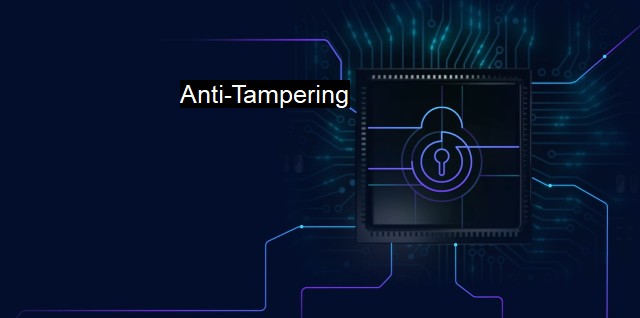What is Anti-Tampering?
Unmasking Anti-Tampering: Understanding the Growing Threat to Cybersecurity Measures in a Digital Age
Anti-tampering refers to various methods implemented to prevent unwanted alterations of products, software, hardware, electronic goods, or official documentation. anti-tampering is a defensive measure that aims to prevent unauthorized access, modifications, and potential disruptions to a machine's critical state, functions, or data. These disruptions might arise from hackers, cyber-criminals, or any other bad-actors who attempt to inject, elevate, or execute harmful code and actions.Anti-tampering technology secures both software and hardware components. On hardware devices, protecting firmware and device integrity is paramount. These measures prevent intruders from physically tampering with hardware components to obtain critical data or gain unauthorized access.
As for software, anti-tampering functions stoop where the application's code begins. For instance, it offers protection against attacks such as reverse-engineering where cyber-criminals try to reverse and modify application codes to perform malicious actions. In the physical world, it would be like changing the locks on a bank vault without the bank knowing, allowing the intruder unrestricted access. Anti-tampering measures ensure such attempts are blocked by reinforcing the 'locks' and consistently testing their strength.
Modern anti-tampering technology incorporates a range of security implements. Defensive measures extend beyond simple password protocols and basic firewalls to complex cryptographic techniques. These novel inclusions increase the level of protection against more advanced threats, including evolving forms of malware that develop relentless techniques of infiltration and manipulation.
Another strategy within anti-tampering technology is protective wrapping, where in several layers of security are engineered around the software or hardware that needs protecting. It's like having multiple fences or guards around a building, sequentially arranged to counter blended attacks, which target more than one system vulnerability simultaneously.
Obfuscation is one such way to instigate anti-tampering technology in the code. This concept is essentially about rewriting the code in random patterns which makes understanding and replicating it much harder. Attempting to reverse engineer such obfuscated code becomes arduously difficult for cyber-thieves.
Along with preventing tampering, these measures also pave the way towards quick detection and response to threats. Some advanced anti-tampering technologies can even confuse attackers by presenting them with false information and trapping them within closed, controlled systems, which can further direct impending investigations.
In antivirus systems specifically, anti-tampering features are essential to prevent any unauthorized disabling, modification or deletion of security services. Antiviruses are programmed to actively look for intrusive patterns and once recognised, to call for appropriate solutions to neutralise them, an ability that could be compromised if tampered with.
It's important to note that though anti-tampering technology is incredibly vital, it should not be the only line of defense. Anti-tampering has its limits, and while five locks on a door make it harder to pick, a sophisticated enough attack may still break it. As a result, it's essential to recognize that cybersecurity requires a multi-pronged approach combining anti-tampering, intrusion detection and prevention, vigilant monitoring, as well as continuous improvement and education in maintaining a resilient cybersecurity framework.
Looking forward, the need for anti-tampering technology will only grow given the increasing digitization of business operations and everyday-life transactions today. Ensuring robust safety norms and anti-tampering practices play an unquestionably important role in navigating the various cyber threats looming across the digital landscape.

Anti-Tampering FAQs
What is anti-tampering in cybersecurity?
Anti-tampering refers to measures taken to prevent malicious users from modifying the code or data of software applications or systems. In cybersecurity, it is an essential part of protecting systems from malware attacks and ensuring the integrity of the software. This technique helps prevent unauthorized access, data loss, and system damage.How does anti-tampering work in antivirus software?
Anti-tampering in antivirus software is usually achieved through code obfuscation, encryption, and digital signatures. By obfuscating and encrypting code, it becomes more challenging for attackers to analyze and modify the program's functionality. Digital signatures guarantee the software's authenticity and ensure that no one else has tampered with it without being detected.What are the benefits of using anti-tampering in cybersecurity?
Anti-tampering provides several benefits in cybersecurity, such as increasing the software's reliability and reducing the risk of cyber-attacks. It helps in maintaining data integrity and confidentiality by preventing hackers from tampering with sensitive information. It also helps reduce the possibility of malware-infected software from being installed onto a system by detecting malicious tampering attempts.Can anti-tampering be bypassed, and if so, how?
It's possible to bypass anti-tampering measures; attackers can use techniques such as reverse engineering, code injection, and debugging to find and exploit vulnerabilities in the software. To prevent this, it is crucial to update the anti-tampering tools regularly and implement additional security measures such as intrusion detection and monitoring to monitor and prevent unauthorized access.Related Topics
Tamper Protection Tamper Detection Code Signing Anti-Virus Protection Malware Analysis
| | A | | | B | | | C | | | D | | | E | | | F | | | G | | | H | | | I | | | J | | | K | | | L | | | M | |
| | N | | | O | | | P | | | Q | | | R | | | S | | | T | | | U | | | V | | | W | | | X | | | Y | | | Z | |
| | 1 | | | 2 | | | 3 | | | 4 | | | 7 | | | 8 | | |||||||